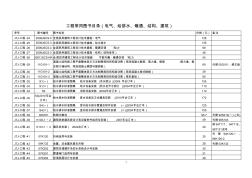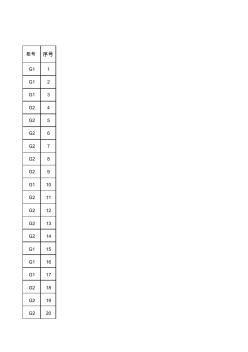工程结构变形协调控制方法及应用(英文版)图书目录
1 Engineering Structure-Related Stable Equilibrium and Deformation Compatibility Control Method
1.1 Compatibility of Engineering Structure System and Mechanics Analysis
1.1.1 Deformation Compatibility Control Problems
According to Past Engineering Structure Cases
1.1.2 Implied Deformation Compatibility Control Condition in the Application of Newtonian Mechanics and Experimental Mechanics
1.2 Three Problems Identified in the Safe State of Engineering Structure
1.2.1 Problem in the Conversion of Structure Equilibrium
1.2.2 Problem in Branch Point Stability
1.2.3 Problem in Structure Deformation Compatibility
1.3 Approaches to Solving Different Engineering Problems and Their Concepts
1.3.1 Solution to the “Apple and Leaf” Problems
1.3.2 Engineering Mechanical Analysis of Steady-State and Nonsteady-State Structures
1.4 Deformation Incompatibility of Engineering Structure Inducing Damage Concentration on Weak Parts of the Structure
1.5 Deformation Compatibility Control Method for Engineering Structures
2 Engineering Deformation Compatibility Control Method and Structural Safety Management
2.1 Effect of Deformation Compatibility Control on the Transmission or Transfer of Force in Structural Systems
2.2 Application Effectiveness of Deformation Compatibility Control Method in Bridge Structures
2.2.1 Comparison of Damage Accumulation on Simple Support Bridge Before and After Bridge Reinforcement
2.2.2 Accumulated Damage Test on Bowstring Arch Bridge Structures
2.2.3 Deformation Compatibility Control Problems in Bridge Expansion Device and Deck Paving
2.2.4 Deformation Compatibility Control Problem Associated with Bridge Safety in Mountain Areas
2.3 Application Effectiveness of Deformation Compatibility Control Method in Tunnel Structure
2.3.1 Deformation Compatibility Control Measures for Mountain Tunnel
2.3.2 Deformation Compatibility Control Measures for Shield Tunneling
2.3.3 Application Effectiveness of Deformation Compatibility Control Method in Metastable Tunnel Construction
2.3.4 Application Effectiveness of Deformation Compatibility Control Method in the Construction of Soft Plastic-Flow Soil Tunnel
2.4 Application Effectiveness of Deformation Compatibility Control Method in the Management of “Bump at Bridgehead” on Soft Soil Road Foundation
2.4.1 Uneven Subsidence of Soft Soil Road Foundation
2.4.2 Comparison Test and Calculation Analysis of Integrity and Friability of Bridge-Head Soft Soil Road Foundation
2.4.3 Comparison of Soft Soil Foundation Strength and Rheological Properties in Tests
2.4.4 Basic Law and Design Method for Soft Soil Foundation
2.4.5 Introduction to Successful Management of Soft Soil Road Foundations
Comments from Sun Jun
Bibliography
Afterword2100433B
工程结构变形协调控制方法及应用(英文版)造价信息
《工程结构变形协调控制方法及应用(英文版)》为“中国工程技术前沿系列(英文版)”之一,作者朱汉华、周智辉、陈孟冲、邓检良通过4万余个满足稳定平衡的工程案例进行整体统计分析,揭示了工程结构变形协调控制问题。即,大部分理论上满足稳定平衡的工程结构,通过类比、试验等手段进行综合修正后,自然满足变形协调控制条件,此类工程结构是安全的;反之,部分工程结构理论上满足稳定平衡而不满足变形协调控制调节,这部分结构就不同程度地存在一些问题甚至是安全风险。
工程结构变形协调控制方法及应用(英文版)图书目录常见问题
-
第2版前言第1版前言第1章 土方工程1.1 土的分类与工程性质1.2 场地平整、土方量计算与土方调配1.3 基坑土方开挖准备与降排水1.4 基坑边坡与坑壁支护1.5 土方工程的机械化施工复习思考题第2...
-
第一篇 综合篇第一章 绿色建筑的理念与实践第二章 绿色建筑评价标识总体情况第三章 发挥“资源”优势,推进绿色建筑发展第四章 绿色建筑委员会国际合作情况第五章 上海世博会园区生态规划设计的研究与实践第六...
-
前言第一章 现代设计和现代设计教育现代设计的发展现代设计教育第二章 现代设计的萌芽与“工艺美术”运动工业革命初期的设计发展状况英国“工艺美术”运动第三章 “新艺术”运动“新艺术”运动的背景法国的“新艺...
工程结构变形协调控制方法及应用(英文版)图书目录文献

 工程常用图书目录
工程常用图书目录
1 工程常用图书目录(电气、给排水、暖通、结构、建筑) 序号 图书编号 图书名称 价格(元) 备注 JTJ-工程 -24 2009JSCS-5 全国民用建筑工程设计技术措施-电气 128 JTJ-工程 -25 2009JSCS-3 全国民用建筑工程设计技术措施-给水排水 136 JTJ-工程 -26 2009JSCS-4 全国民用建筑工程设计技术措施-暖通空调 ?动力 98 JTJ-工程 -27 2009JSCS-2 全国民用建筑工程设计技术措施-结构(结构体系) 48 JTJ-工程 -28 2007JSCS-KR 全国民用建筑工程设计技术措施 节能专篇-暖通空调 ?动力 54 JTJ-工程 -29 11G101-1 混凝土结构施工图平面整体表示方法制图规则和构造详图(现浇混凝土框架、剪力墙、框架 -剪力墙、框 支剪力墙结构、现浇混凝土楼面与屋面板) 69 代替 00G101

 电厂图书目录
电厂图书目录
柜号 序号 G1 1 G1 2 G1 3 G2 4 G2 5 G2 6 G2 7 G2 8 G2 9 G1 10 G2 11 G2 12 G2 13 G2 14 G1 15 G1 16 G1 17 G2 18 G2 19 G2 20 G1 21 G3 22 G3 23 G3 24 G3 25 G3 26 G3 27 G1 28 G1 29 G3 30 G3 31 G2 32 G2 33 G2 34 G2 35 G2 36 G2 37 G2 38 下右 39 下右 40 下右 41 下右 42 下右 43 下右 44 下右 45 下右 46 下右 47 下右 48 下右 49 下右 50 下右 51 下右 52 下右 53 下左 54 下左 55 下左 56 下左 57 下左 58 下左 59 下左 60 下左 61 下左 62 下左 63 下左 64 下左 65 下左 66 下左 67 下
《土木工程结构变形协调与受力安全》是在《土木工程结构受力安全问题的思考》的基础上,凝练土木工程结构设计施工经验和教训,总结作者多年的思考而形成,适合研究、设计、施工、管理人员参考使用。作者朱汉华、周智辉、范立峰、文颖根据30余年亲身主持工程建设的实践,以问题为导向,参考同类著作,结合对古今中外土木工程4万多个案例的分析,阐述了合理工程结构体系及其力学分析的基本要求——“稳定平衡与变形协调”。其核心是:①如何设计合理的工程结构体系;②如何系统地应用牛顿力学分析解决实际工程中的结构安全问题。
针对土木工程结构安全问题,作者朱汉华、周智辉、范立峰、文颖根据30余年亲身主持工程建设的实践,以问题为导向,参考同类著作,结合对古今中外土木工程4万多个案例的分析,阐述了合理工程结构体系及其力学分析的基本要求——“稳定平衡与变形协调”。其核心是:①如何设计合理的工程结构体系;②如何系统地应用牛顿力学分析解决实际工程中的结构安全问题。
《土木工程结构变形协调与受力安全》在思考力学理论与转变思维方式的基础上,系统地梳理了对土木工程现象统计“相关性”和物理规律“因果性”的认识,对解决“苹果与树叶落地点预测”两类问题思维和方法的认识,对稳定状态与非稳定状态结构工程力学分析方法的认识。同时,结合具体的土木工程案例进行受力安全分析,具有较大的理论意义和工程应用价值。
《土木工程结构变形协调与受力安全》适合从事土木工程结构科研、设计、施工、监理、监督及管理的技术人员和相近专业的研究人员使用,也可供其他关注土木工程安全的人员参考。
机炉协调控制方法从其控制结构出发有2种指导思想:一种是以反馈控制为基础的,适当加入一些前馈信号作为辅助调节以改善控制品质;另一种则从能量平衡的角度考虑前馈的控制,力争做到前馈补偿后,锅炉和汽轮机就能协调一致地达到所需要的负荷,反馈作用仅在此基础上起校正作用。这样机炉主控制器就有2种分类方法:一种以反馈回路分类,一种以能量平衡分类 。
机炉协调控制系统以反馈回路分类
1) 以锅炉跟随主汽轮机方式为基础的协调控制系统;
2) 以主汽轮机跟随锅炉方式为基础的协调控制系统
机炉协调控制系统以能量平衡分类可分
1)直接能量平衡控制系统;
2)间接能量平衡控制系统。
- 相关百科
- 相关知识
- 相关专栏
- 工程结构可靠度
- 工程结构可靠性原理
- 工程结构可靠性原理及其优化设计
- 工程结构可靠性设计原理
- 工程结构可靠性设计统一标准
- 工程结构可靠性设计统一标准 GB50153-2008(英文版
- 工程结构可靠性设计统一标准 GB50153-2008(英文版)
- 工程结构基础设计
- 工程结构多用途抗火试验系统
- 工程结构安全系数
- 工程结构安全鉴定加固技术与工程实例
- 工程结构广义可靠性理论
- 工程结构弹塑性地震反应
- 工程结构弹性稳定计算
- 工程结构性能的数值分析及实例
- 工程结构抗震分析
- 电气工程及其自动化特色专业建设探索
- 分形DGS单元结构设计及其在微带电路中的应用
- 磷铵技术改造五大磷肥工程的建议
- 预制砌块(砖、石)挡土墙工程砌体施工安全技术交底
- 应用模糊数学理论对公路工程建设项目方案的综合评价
- 引嫩工程扩建区土壤水盐动态与防治土壤盐碱措施
- 中国工程图学学会成立工程与制造系统集成化分会
- 医院病房楼工程施工装饰装修工程施工控制
- 在生活中构筑自然——河南天旺园林工程有限公司剪影
- 中国机械工程学会授予材料热处理工程师资格人员名单
- 以贯穿项目为核心载体的建筑工程技术专业素材库建设
- 中国被动式太阳房及太阳能建筑市场监测及发展策略研
- 云计算技术在城市轨道交通运营指挥管理系统中的应用
- 多逆变器太阳能光伏并网发电系统的组群控制方法
- 中国工程造价咨询业的发展趋势
- 支持并行工程和智能CAPP的制造资源建模技术